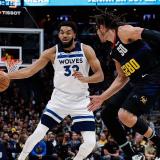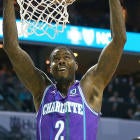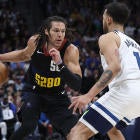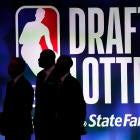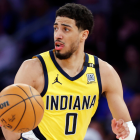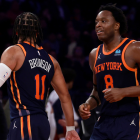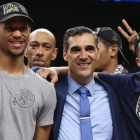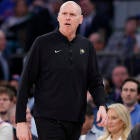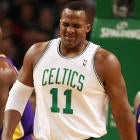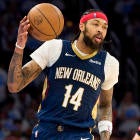The NBA trade deadline creates a number of logistical challenges to teams with real championship aspirations. Oftentimes those teams are short on trade assets because those assets were spent building a contender in the first place. They usually lack tradable salary because their highly-paid players are usually essential parts of their rotation.
That isn't to say that winning teams don't make trades in February. It's just that only a few of them have produced championships. The blockbusters that sent Marc Gasol to the Toronto Raptors and Rasheed Wallace to the Detroit Pistons are the exception.
The buyout market, on the other hand, is the rule. Both NBA finalists used free agency add a player after the trade deadline last season. Andrew Bogut wound up playing a meaningful role for the Golden State Warriors. Jeremy Lin didn't for the Raptors, but plenty of recent champions have bolstered their roster through a midseason free-agent addition. P.J. Brown got the 2008 Boston Celtics into the Eastern Conference finals. Boris Diaw landed with the San Antonio Spurs in 2012 and wound up staying as a critical reserve on their 2014 championship team. Chris Andersen won two titles with the Miami Heat.
Every team in the playoff hunt wants to get better. Not everyone has the means to do so through a trade. But almost anyone can pluck midseason free agents with the right recruiting pitch. The blockbusters may stop on Thursday, but teams are far from finished constructing their rosters.
So how will they go about it? What exactly is the buyout market, and how will teams use it in pursuit of a championship? This trusty guide should answer any and all questions on the subject. Below is your 2020 buyout market primer.
How do buyouts work?
A buyout occurs when a player and team mutually decide to part ways. The player surrenders an agreed-upon amount of his guaranteed salary, and in exchange, is released and allowed to sign with any other team as a free agent. If a team buys a player out, he cannot re-sign with or be claimed off of waivers by that team for one year or until the end of the contract that was bought out, whichever comes later.
That clause typically lasts one year, though, as buyouts on multiyear deals are a rarity. Typically, the kind of player that gets bought out fits the following criteria:
- Is in the final year of his contract.
- Is a veteran whose age, injury history, declining skills or positional redundancy limits his original team's interest in retaining him as a free agent in the upcoming offseason.
- Is currently on, or traded to before the deadline, a lottery team that has little to gain by employing such a veteran for the remainder of a season.
The motivations are simple for both sides. The team is able to save a bit of money. The player is allowed to pick a new team that better suits him at that moment. Usually, they are motivated either by a desire to compete for a championship or a chance to play more minutes on a roster that better suits them in an effort to increase their value as a free agent in the offseason.
What timeline does the mid-season free agency market generally follow?
Buyout negotiations typically begin in earnest once the trade deadline has passed. At that point, teams know for certain who has and has not been traded and what needs they still have to fill. News will begin pouring in almost immediately at 3 p.m. ET about who could hit the market and where they might land.
Not all buyouts are negotiated over night, though. While the trade deadline is on Feb. 6, teams have several weeks to decide whether or not they want to buy out their players. The unofficial deadline to do so is March 1. While players can still be bought out after that point, such players are not eligible to play in the postseason for a new team if they are waived after that. Players who were not under contract with any team prior to March 1, however, are postseason eligible as long as they sign before the end of the regular season.
That brings up another important point: while most mid-season free agents come from buyouts, there is another talent pool that opens up after the deadline. Many foreign leagues end before the regular season, and their veteran free agents are free to join NBA teams once they do.
Andrew Bogut, who had been playing in Australia last season, did just that in signing with the Golden State Warriors after the NBL's season ended. The Finals in Australia's NBL begin on March 6. It is a five-game series, and once it concludes, some of the players involved will get looks from NBA teams. The Chinese CBA also tends to have players that interest NBA teams, particularly with their two roster slots designated for international players (who usually happen to be American). However, the outbreak of coronavirus has suspended the league's operations, so it is unclear when that season will end. Usually, the regular season concludes in the middle of March. Once a CBA player's season is over, if his contract has expired, he is free to sign with an NBA team.
How can teams afford to sign free agents in the middle of the season?
Only one NBA team is currently below the salary cap. That team is the Atlanta Hawks, and they are unlikely to factor into the buyout market given their poor record. Managing the cap is therefore a critical element of buyout season.
Most buyout contracts are worth the minimum salary. From a cap perspective, that means that most buyout contracts are worth the same amount, which would be a pro-rated portion of the minimum salary for a second-year player (as the league reimburses teams for the extra salary of older players to prevent teams from intentionally targetting younger ones). For the whole season, that would be around $1.62 million, but the actual amount paid to a player and counted beneath the cap depends on when the contract is signed. The regular season is 174 days long. The trade deadline falls on the 105th day of the season. Therefore, a player would receive roughly 39.7 percent of that minimum figure if he signed with a new team on deadline day, and slightly less with each passing day.
Almost any team can sign as many minimum-salaried players as they'd like, provided it has the roster spots to fit them. This season, there are two exceptions: the Miami Heat and Golden State Warriors. By virtue of acquiring a player via sign-and-trade this offseason (Jimmy Butler for the Heat, D'Angelo Russell for the Warriors), those teams were hard-capped at the apron, which this season is just under $138.93 million. They cannot exceed that number for any reason. It should be noted that a number of other teams face that same restriction, but have more than enough room underneath it to comfortably operate within the buyout market. The Heat and Warriors barely have any wiggle room. Neither should be active in the buyout market.
While the minimum salary is the baseline for buyout players, a number of contenders have a major financial advantage over the competition in the form of cap exceptions. There are two primary forms of exceptions that come into play with mid-season free agency. The first is the Mid-Level Exception. Most contending teams spend their entire exception during the offseason's free agency. A few, however, save some or all of it for use during the regular season. The following potential playoff teams saved a portion of their Mid-Level Exception big enough to make an offer above the pro-rated minimum to bought-out free agents (via Luke Adams of Hoops Rumors):
- Denver Nuggets ($4,819,690)
- Houston Rockets ($2,154,653)
- Oklahoma City Thunder ($4,097,436)
- San Antonio Spurs ($3,758,000)
These exceptions pro-rate slightly, but not at the rate of a minimum-salary deal. As there are 174 days in the regular season, these figures all lose 1/174th of their value with each passing day, but that clock only starts on Jan. 10, so these teams will have a bit less than this to offer, but still more than the minimum. It should be noted that the Warriors and Heat both have substantial portions of their Mid-Level Exceptions remaining as well, but their hard cap restraints make them functionally worthless barring a trade.
The other major type of exception on the table is the Disabled Player Exception. Teams are eligible to apply for a DPE when one of their players gets injured. If a league-approved doctor deems that player unlikely to be healthy by the end of the league year, the team is granted a cap exception that can be used in free agency or trades worth half of that player's salary or the Non-Taxpayer Mid-Level Exception, whichever is lower. Unlike the other exceptions mentioned, Disabled Player Exceptions do not prorate. The following potential playoff teams have Disabled Player Exceptions (once again via Hoops Rumors):
- Orlando Magic ($4,629,000)
- New Orleans Pelicans ($3,625,000)
- Portland Trail Blazers ($2,859,000)
- Los Angeles Lakers ($1,750,000)
- Brooklyn Nets ($839,427)
Money is rarely the deciding factor for a free agent who has been bought out, but it never hurts. Conversely, just having this money doesn't mean every team will spend it. Several of the teams listed here have to contend with the luxury tax, or won't be able to recruit a top player, or simply won't have any interest in altering their existing roster. The money is merely a tool at their disposal. It is up to them to make the most of it.
Who are the top potential buyout candidates this season?
This list is simultaneously incomplete and overstuffed. Ultimately, there is no set formula that leads to a buyout, so we'll try to use the criteria above while also establishing a few other categories to watch. There will be notable players to get buyouts that are not listed here. There will also be plenty of players on this list that don't get bought out. But on paper, these are the players to watch in midseason free agency, either because they have already changed teams, or because there is a chance they still might.
Veterans with expiring contracts on bad teams
- Evan Turner, F, Minnesota Timberwolves
- Marvin Williams, F, Charlotte Hornets (has joined the Milwaukee Bucks)
- Michael Kidd-Gilchrist, F, Charlotte Hornets (has joined the Dallas Mavericks)
- BIsmack Biyombo, C, Charlotte Hornets
- John Henson, C, Detroit Pistons
- Reggie Jackson, G, Detroit Pistons (has joined the Los Angeles Clippers)
- Markieff Morris, F, Detroit Pistons (has joined the Los Angeles Lakers)
- Matthew Dellavedova, G, Cleveland Cavaliers
- Langston Galloway, G, Detroit Pistons
- Allen Crabbe, G, Minnesota Timberwolves
- Tyler Johnson, G, Phoenix Suns
- DeMarre Carroll, F, San Antonio Spurs (has joined the Houston Rockets)
Currently sitting out
- Darren Collison, G, Retired
Playing in a foreign league
- Andrew Bogut, C, Sydney Kings
- Miles Plumlee, C, Perth Wildcats
- Jerryd Bayles, G, Sichuan Blue Whales
- Marshon Brooks, G, Guangdong Southern Tigers
- Dante Cunningham, F, Fujian Sturgeons
- Jeremy Lin, G, Beijing Ducks
- Jarell Martin, F, Shenzhen Leopards
- Lance Stephenson, G, Liaoning Flying Leopards











